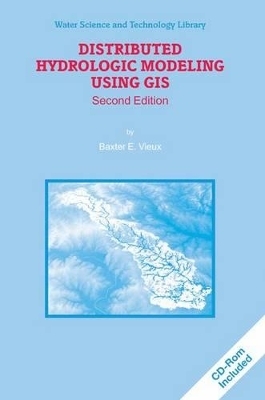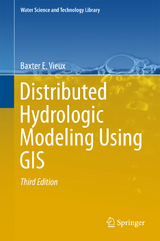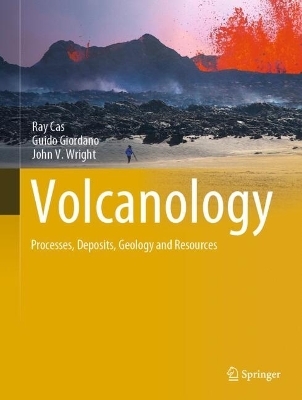
Distributed Hydrologic Modeling Using GIS
Springer-Verlag New York Inc.
978-1-4020-2459-7 (ISBN)
- Titel erscheint in neuer Auflage
- Artikel merken
1. 5 REFERENCES 127 7 DIGITAL TERRAIN 129 1. 1 INTRODUCTION 129 1. 2 DRAINAGE NETWORK 130 1. 3 DEFINITION OF CHANNEL NETWORKS 135 1. 4 RESOLUTION DEPENDENT EFFECTS 138 1. 5 CONSTRAINING DRAINAGE DIRECTION 141 1. 6 SUMMARY 145 1. 7 REFERENCES 146 8 PRECIPITATION MEASUREMENT 149 1. 1 INTRODUCTION 149 1. 2 RAIN GAUGE ESTIMATION OF RAINFALL 151 ADAR STIMATION OF RECIPITATION 1. 3 R E P 155 1. 4 WSR-88D RADAR CHARACTERISTICS 167 1. 5 INPUT FOR HYDROLOGIC MODELING 172 1. 6 SUMMARY 174 1. 7 REFERENCES 175 9 FINITE ELEMENT MODELING 177 1. 1 INTRODUCTION 177 1. 2 MATHEMATICAL FORMULATION 182 1. 3 SUMMARY 194 1. 4 REFERENCES 195 10 DISTRIBUTED MODEL CALIBRATION 197 1. 1 INTRODUCTION 197 1. 2 CALIBRATION APPROACH 199 1. 3 DISTRIBUTED MODEL CALIBRATION 201 1. 4 AUTOMATIC CALIBRATION 208 1. 5 SUMMARY 214 1. 6 REFERENCES 214 11 DISTRIBUTED HYDROLOGIC MODELING 217 1. 1 INTRODUCTION 218 1. 2 CASE STUDIES 218 1. 3 SUMMARY 236 1. 4 REFERENCES 237 12 HYDROLOGIC ANALYSIS AND PREDICTION 239 1. 1 INTRODUCTION 239 x Distributed Hydrologic Modeling Using GIS 1. 2 VFLO(TM) EDITIONS 241 1. 3 VFLO(TM) FEATURES AND MODULES 242 1. 4 MODEL FEATURE SUMMARY 245 1. 5 VFLO(TM) REAL-TIME 256 1.
6 DATA REQUIREMENTS 258 1. 7 RELATIONSHIP TO OTHER MODELS 259 1. 8 SUMMARY 260 1.
Dedication.- Preface.- Foreword.- Acknowledgments.- 1 Distributed Hydrologic Modeling.- 1.1 Introduction. 1.2 Why Distributed Hydrologic Modeling? 1.3 Distributed Model Representation. 1.4 Mathematical Analogy. 1.5 GIS Data Structures and Sources. 1.6 Surface Generation. 1.7 Spatial Resolution and Information Content. 1.8 Runoff Processes. 1.9 Hydraulic Roughness. 1.10 Drainage Networks and Resolution. 1.11 Spatially Variable Precipitation. 1.12 Distributed Hydrologic Model Formulation. 1.13 Distributed Model Calibration. 1.14 Case Studies. 1.15 Hydrologic Analysis and Prediction. 1.16 Summary. 1.17 References. 2 Data Sources And Structure.- 1.1 Introduction. 1.2 Dimensionality. 1.3 Map Scale and Spatial Detail. 1.4 Datum and Scale. 1.5 Georeferenced Coordinate Systems. 1.6 Map Projections. 1.7 Data Representation. 1.8 Watershed Delineation. 1.9 Soil Classification. 1.10 Land use/Cover Classification. 1.11 Summary. 1.12 References. 3 Surface Generation.- 1.1 Introduction. 1.2 Surface Generators. 1.3 Surface Generation Application. 1.4 Summary. 1.5 References. 4 Spatial Variability.- 1.1 Introduction. 1.2 Information Content. 1.3 Fractal Interpretation. 1.4 Resolution Effects on DEMs. 1.5 Summary. 1.6 References. 5 Infiltration Modeling.- 1.1 Introduction. 1.2 Infiltration Process. 1.3 Approaches to Infiltration Modeling. 1.4 Green-Ampt theory. 1.5 Estimation of Green-Ampt Parameters. 1.6 Attribute Error. 1.7 Summary. 1.8 References. 6 Hydraulic Roughness.- 1.1 Introduction. 1.2 Hydraulics of Surface Runoff. 1.3 Application to the Illinois River Basin. 1.4 Summary. 1.5 References. 7 Digital Terrain.- 1.1 Introduction. 1.2 Drainage Network. 1.3 Definition of Channel Networks. 1.4 Resolution Dependent Effects. 1.5 Constraining Drainage Direction. 1.6 Summary. 1.7 References. 8 Precipitation Measurement.- 1.1 Introduction. 1.2 Rain Gauge Estimation of Rainfall. 1.3 Radar Estimation of Precipitation. 1.4 WSR-88D Radar Characteristics. 1.5 Input for Hydrologic Modeling. 1.6 Summary. 1.7 References. 9 Finite Element Modeling.- 1.1 Introduction. 1.2 Mathematical Formulation. 1.3 Summary. 1.4 References. 10 Distributed Model Calibration.- 1.1 Introduction. 1.2 Calibration Approach. 1.3 Distributed Model Calibration. 1.4 Automatic Calibration. 1.5 Summary. 1.6 References. 11 Distributed Hydrologic Modeling.- 1.1 Introduction. 1.2 Case Studies. 1.3 Summary. 1.4 References. 12 Hydrologic Analysis And Prediction.- 1.1 Introduction. 1.2 Vflo(TM) Editions. 1.3 Vflo(TM) Features and Modules. 1.4 Model Feature Summary. 1.5 Vflo(TM) Real-time. 1.6 Data Requirements. 1.7 Relationship to Other Models. 1.8 Summary. 1.9 References. Glossary.- Index
| Erscheint lt. Verlag | 1.12.2004 |
|---|---|
| Reihe/Serie | Water Science and Technology Library ; v. 48 |
| Zusatzinfo | biography |
| Verlagsort | New York, NY |
| Sprache | englisch |
| Maße | 155 x 235 mm |
| Gewicht | 615 g |
| Themenwelt | Naturwissenschaften ► Biologie ► Ökologie / Naturschutz |
| Naturwissenschaften ► Geowissenschaften ► Hydrologie / Ozeanografie | |
| ISBN-10 | 1-4020-2459-2 / 1402024592 |
| ISBN-13 | 978-1-4020-2459-7 / 9781402024597 |
| Zustand | Neuware |
| Haben Sie eine Frage zum Produkt? |
aus dem Bereich


